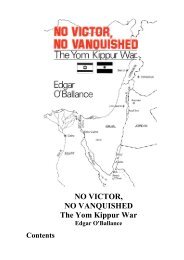israeli fortifications of the october war 1973
israeli fortifications of the october war 1973
israeli fortifications of the october war 1973
Create successful ePaper yourself
Turn your PDF publications into a flip-book with our unique Google optimized e-Paper software.
EYES HAVE THEY BUT THEY SEE NOT,<br />
PSALM 135: 16<br />
Within two months <strong>of</strong> <strong>the</strong> ceasefire, President Nasser died <strong>of</strong> a heart attack<br />
on 28 September 1970 and was succeeded by his vice president, An<strong>war</strong><br />
al-Sadat. Like his predecessor, President Sadat was determined to reclaim <strong>the</strong><br />
lost lands <strong>of</strong> <strong>the</strong> Sinai by any means possible be <strong>the</strong>y political or military.<br />
However, his extravagant pronouncements that he was willing 'to sacrifice a<br />
million Egyptian lives' to achieve <strong>the</strong>se ends and his continuing prevarication<br />
when 1971 was to have been 'The Year <strong>of</strong> Decision' only tended to reinforce<br />
Israeli perceptions that he was a weak leader. Never<strong>the</strong>less, with no political<br />
progress through 1971 and into 1972, President Sadat decided that <strong>war</strong> was<br />
<strong>the</strong> only remaining option in November 1972. His expulsion <strong>of</strong> thousands <strong>of</strong><br />
Soviet military advisers from Egypt in July had galvanized <strong>the</strong> Kremlin into<br />
providing more sophisticated weaponry such as <strong>the</strong> T-62 MBT in large<br />
numbers as well as <strong>the</strong> highly effective SA-6 anti-aircraft missile system.<br />
Detailed planning for a limited <strong>war</strong> now began.<br />
Despite a general improvement in <strong>the</strong> quality <strong>of</strong> <strong>the</strong> armed forces, <strong>the</strong><br />
Egyptian high command remained fully a<strong>war</strong>e <strong>of</strong> <strong>the</strong> strengths <strong>of</strong> <strong>the</strong> IDF,<br />
particularly <strong>the</strong>ir superiority in <strong>the</strong> air and in manoeuvre <strong>war</strong>fare. The former<br />
was to be contained by <strong>the</strong> rapidly expanding Air Defence Command and<br />
<strong>the</strong> latter was to be broken by an unprecedented deployment <strong>of</strong> anti-tank<br />
guided weapons in <strong>the</strong> front lines, as discussed previously. In order to<br />
maximize <strong>the</strong> performance <strong>of</strong> <strong>the</strong> Malyutka or Sagger missiles, <strong>the</strong>se were<br />
employed by highly trained soldiers from <strong>the</strong> artillery branch that were<br />
attached to <strong>the</strong> infantry divisions as a concerted screen against any armoured<br />
attack. Fundamental to <strong>the</strong> plan, codenamed High Minarets, was for <strong>the</strong><br />
Egyptian army to attack across <strong>the</strong> Suez Canal on a broad front and secure<br />
an extensive lodgement in <strong>the</strong> Sinai Desert while remaining under <strong>the</strong> missile<br />
umbrella <strong>of</strong> SA-75 and S-125 SAM sites on <strong>the</strong> western bank <strong>of</strong> <strong>the</strong> canal: a<br />
distance <strong>of</strong> no more than 16km. The political logjam would thus be broken<br />
and a negotiated settlement could <strong>the</strong>n follow. The assault was to be<br />
coordinated with a major <strong>of</strong>fensive by <strong>the</strong> Syrian Army to regain <strong>the</strong> Golan<br />
Heights so as to force <strong>the</strong> IDF to fight on two fronts simultaneously. But first,<br />
<strong>the</strong> formidable obstacles <strong>of</strong> <strong>the</strong> Suez Canal and <strong>the</strong> sand ramparts protecting<br />
<strong>the</strong> Bar Lev Line had to be overcome.<br />
Major-General Gamal Mohamed Ali fought in <strong>the</strong> 1948, 1956 and 1967<br />
Arab-Israeli Wars and was Commander <strong>of</strong> <strong>the</strong> Engineer Corps before and<br />
during <strong>the</strong> October War <strong>of</strong> <strong>1973</strong>, so it is only appropriate that his<br />
recollections <strong>of</strong> Egyptian preparations should be recounted in what became<br />
a remarkable feat <strong>of</strong> arms:<br />
The crossing <strong>of</strong> <strong>the</strong> Suez Canal- <strong>the</strong> largest water barrier ever traversed in <strong>the</strong><br />
history <strong>of</strong> <strong>war</strong>fare - could not have been completed successfully without<br />
overcoming ano<strong>the</strong>r barrier on <strong>the</strong> eastern bank. This was <strong>the</strong> enormous<br />
fortified artificial sand barrier that extended along <strong>the</strong> Bar Lev line. This<br />
barrier ranged from eight to 20m in height and was eight to 10m deep. The<br />
barrier was equipped with tank and direct fire positions and interspersed with<br />
fortified positions at approximately four kilometre intervals along its entire<br />
length from Port Tewfiq to East Qantara. It was made <strong>of</strong> a highly compact<br />
mixture <strong>of</strong> sand and mud. The sand barrier was one <strong>of</strong> <strong>the</strong> greatest challenges<br />
before <strong>the</strong> Egyptian command and military planners. We would have to create<br />
breaches in order to allow for <strong>the</strong> passage <strong>of</strong> forces and military equipment,<br />
without which we would not be able to mount a successful penetration <strong>of</strong> <strong>the</strong><br />
o<strong>the</strong>r side. So formidable was it that Moshe Dayan, former Israeli minister <strong>of</strong><br />
defence, said, 'It would take <strong>the</strong> American and Soviet engineer corps, toge<strong>the</strong>r,<br />
to break through <strong>the</strong> Bar Lev line.' Soviet experts at <strong>the</strong> time said that what<br />
was needed was an atom bomb.<br />
'We conducted numerous experiments in order to determine <strong>the</strong> best way<br />
to overcome <strong>the</strong> barrier at a site on <strong>the</strong> Damietta branch <strong>of</strong> <strong>the</strong> Nile. First we<br />
tried explosives, which were ineffective. Then we tried artillery and mortar<br />
fire, but to no avail. Mechanical equipment was too slow and clumsy. It was<br />
at this point that we thought <strong>of</strong> water guns. Many <strong>of</strong> our <strong>of</strong>ficers had<br />
participated in <strong>the</strong> construction <strong>of</strong> <strong>the</strong> High Dam where <strong>the</strong>y helped transport<br />
five million cubic metres <strong>of</strong> sand using enormous hydraulic pumps that could<br />
suck up 50 cubic meters <strong>of</strong> Nile water per hour, directing it in a powerful<br />
The old military adage <strong>of</strong><br />
always occupying <strong>the</strong> high<br />
ground is graphically illustrated<br />
in <strong>the</strong>se photographs <strong>of</strong> IDF<br />
observation posts guarding <strong>the</strong><br />
vital Mitla and Gidi passes that<br />
were <strong>the</strong> gateways to central<br />
Sinai and from <strong>the</strong>reon to<br />
Israel. From <strong>the</strong>se heights it<br />
was possible to see as far as <strong>the</strong><br />
Suez Canal. (Stuart Bracken)<br />
40 41




